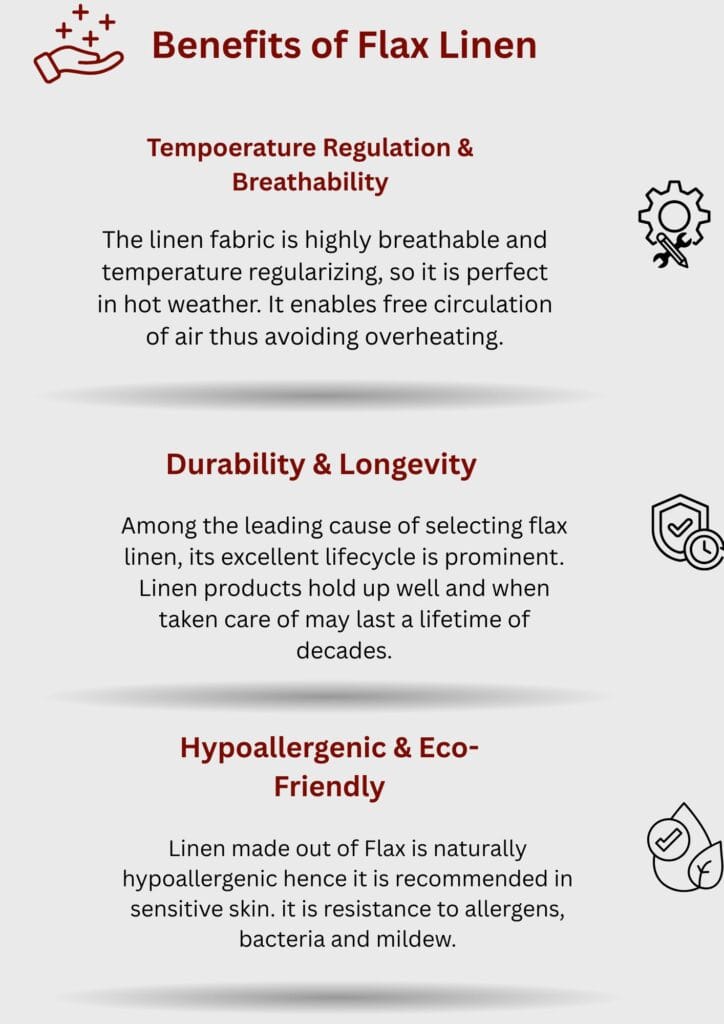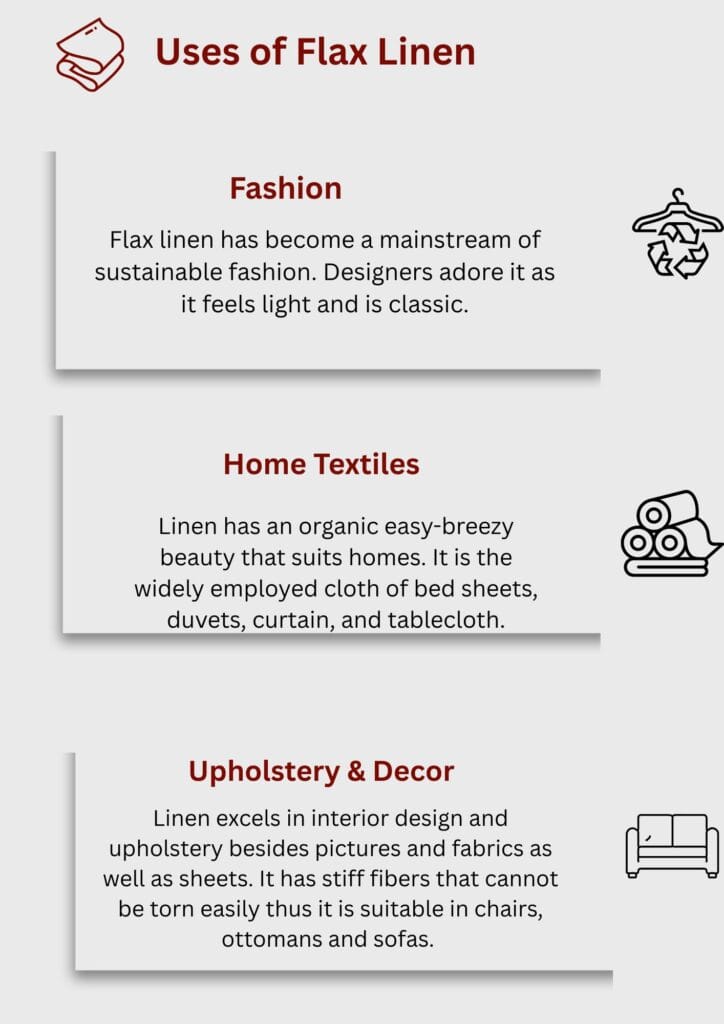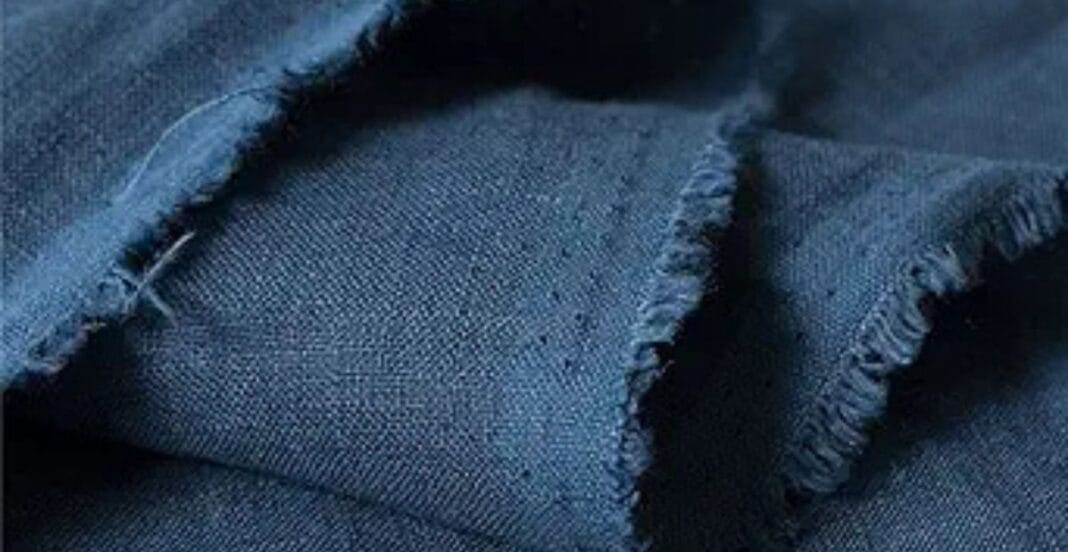Introduction
Flax linen definition.
Flax linen is a natural breathable non-synthetic material produced using fibers of flax plant (Linum usitatissimum). It is one of the luxurious fabrics that are lightweight and sustainable. The uniqueness is that it has a perfect combination of beauty, strength and environmental friendliness. The linen fabric is very popular in the fashion world, home interiors, and even in industries. When you wonder what flax linen is, you consider one of the best and most ancient materials that have ever been developed. Not only this fabric appears beautiful, but it also helps to live in a more sustainable way.
Natural Origins: It is produced with the Flax Plant
The flax plant is one of the flowering crops which is commonly cultivated in Europe particularly in Belgium, France, and Netherlands. Flax uses less pesticides, fertilizers and water when compared with cotton. When it has grown up its fibers are painfully nicked out of the stalks of the plants. These are further converted to threads, and woven to what is known as linen by these long shiny fibers. All parts of flax plant can be utilized, which makes it a zero-waste plant. It is this close association with nature that gives the green credentials and reputation to the flax linen cloth.
Historical Significance: amongst the oldest fabrics
Flax linen has a long history thousands of years old it was used in ancient Egypt as far back as was found out by historians. Pharaohs used to be buried along with linen garments because this symbolized wealth and purity. It was considered strong and cooling by ancient Greeks and Romans as well. With time it became essential in European households. Even nowadays, linen remains the symbol of luxury and sustainability. Beyond the beauty, it is its resilience that has made it stick out in the history of human life.
How Flax Linen Is Made
Cultivation of Flax Plants
The procedure starts with planting the flax plant that can take anywhere between 100 days or it may take more or less depending on the conditions in which it is grown. Flax can also grow best in cooler temperatures and in luscious and wet land. The flax plant does not require artificial chemicals to be grown by farmers thus making the plant low intensity. Due to its fast increase, flax can be used in crop rotation and soil regrowth. These are the elements that have made flax plants to be eco-friendly and would help in making sustainable agriculture.
The Process of Harvesting and Retting
When the flax is mature it is pulled out of the ground instead of being cut. The whole length of the fiber is maintained by this technique and high-quality linen needs this aspect. Following harvesting the plant is retted- a natural process that relies on moisture to break fibers loose of the woody core. Retting may be accomplished under dew, or water, or controlled conditions. Fibers are combed, spun and dried after retting. The nearer the retting is to nature, the softer and finer is the linen.
Weaving and spinning to cloth
Flax fibers are spun out and woven into material after they are separated. The pattern weave identifies the texture and durability of the linen product. denser weaves produce hardwearing linen but breezier weaves are less dense. Linen has become known by its natural slubs (small bumps that appear on flax fibers) in flax threads. These are not faults rather they enhance personality and genuineness. And this last process makes this breathable, timeless property of the fabrics so versatile.
Comparison between Other Fabrics
Flax linen consumes less water and fewer chemicals as compared to cotton. Though cotton is softer at first, linen gets softer each time it is washed and it also is more durable. Linen is also smooth and thinner than hemp yet both fabrics are environmentally friendly. Unlike the more common bamboo (usually made of rayon), flax linen is more environmentally friendly because of their natural, mechanical production. These benefits prove that flax linen is a winner in long-term value and environmental effects.
Benefits of Flax Linen

Tempoerature Regulation & Breathability
The linen fabric is highly breathable and temperature regularizing, so it is perfect in hot weather. It enables free circulation of air thus avoiding overheating. Linen makes you dry and cool in the hot weather. It is the right amount of warmth during cooler nights. This qualifies it as one of the best materials to use on summer clothes and bed sheets as well as beddings. Linen regulates the temperature of your body keeping you comfortable throughout the year.
Durability & Longevity
Among the leading cause of selecting flax linen, its excellent lifecycle is prominent. Linen products hold up well and when taken care of may last a lifetime of decades. Linen becomes stronger with each wash unlike cotton that wears out with time. It does not pill and stretches poorly, it does not lose its color easily. Even the products that are mostly prone to wear and tear such as tablecloths and cushion covers stand up impressively. To get long and durable fabrics, flax linen is a good decision.
Hypoallergenic & Eco-Friendly
Linen made out of Flax is naturally hypoallergenic hence it is recommended in sensitive skin. it is resistance to allergens, bacteria and mildew. It cannot trap dust and irritants since it is chemical-free in its processing. Linen has a low carbon footprint on the environment. It is biodegradable, does not need much water, and it is also not dependent on any harmful pesticides. By wearing flax linen, you can save waste and take care of the planet at once.
Antibacterial & Moisture-Wicking
Linen is naturally moisture wicking, and it keeps you dry and refreshed. It can absorb a maximum of 20 percent of its weight with it not feeling damp. That is why it is ideal as bedding, towels and summer dress. It has anti-bacterial properties that do not allow it to build odor and repels mold. This is the reason why flax linen is typically selected in the humid climates and in the products that are wellness-oriented. It is cool, clean and freshly comfortable.
Uses of Flax Linen

Fashion
Flax linen has become a mainstream of sustainable fashion. Designers adore it as it feels light and is classic. Linen will appear in dresses, blouses, pants and suits, mostly spring and summer collections. The shape of the fabric provides clothing a well-draped fit that does not appear clingy. Besides, it helps to live consciously without losing style. Linen fashion shows that it is possible to be stylish and do right things at the same time.
Home Textiles
Linen has an organic easy-breezy beauty that suits homes. It is the widely employed cloth of bed sheets, duvets, curtain, and tablecloth. Linen bedding will ensure you sleep deep because of its ventilating capabilities as well as its sheer nature. Linen counterparts of curtains allow natural light and provide privacy. Tablecloths add simple sophistication to any dining place. To anyone who is in need of warmth and sophistication, flax linen can be placed superbly in living room.
Upholstery & Decor
Linen excels in interior design and upholstery besides pictures and fabrics as well as sheets. It has stiff fibers that cannot be torn easily thus it is suitable in chairs, ottomans and sofas. Linen covers provide an up-tight luxurious effect. Its organic texture is an attribute that is prominent when used decoratively such as on pillows or on hanging, etc. Linen with its rustic appearance is of particular advantage to minimalist or boho-styled interiors. It combines utility with beauty, easily.
Industrial Uses
Not only used in fashion and decorative purposes, linen is also used in industrial as well as element of art. It has historically been made use in oil painting (in canvas), paper and even banknotes. Due to its durability and lengthy fibre, linen is still a prized material in bookbinding and art. It is long lasting by nature and hence suitable in long lasting products. All these applications indicate the flexibility of flax linen.
Flax Linen vs. Other Fabrics
Linen Vs Cotton
Cotton is popular but flax linen is more sustainable, durable and long-lasting. Linen require minimal amount of water and chemicals to cultivate. It is also longer-lasting and becomes softer. At first cotton can be smoother but it wears out quicker. In case of environment-friendly options, linen wins the day.
Linen / Hemp
Both linen and hemp are eco-friendly materials, but natural differences in these materials will determine their texture and design. Linen is finer, airier and more refined than hemp which is clumsier. Hemp is stronger than linen but linen is more luxurious and comfortable. Both are in their places, yet linen is generally selected in the case of fashion and decor.
Linen vs Synthetic Fabrics
Other inexpensive materials such as polyester and nylon may be cheap to get but their cost to the environment is immense. They are non-biodegradable materials that are made of petroleum products. Linen on the other hand is natural and is compostable. It is less stuffy, it does not expose you to chemicals and it is more in line with the green lifestyle. The decision to wear flax linen is a healthy choice towards the planet.
How to Care for Flax Linen
Washing & Drying Tips
Caring of linen is not a difficult task as long as you follow a few simple rules. Clean in cold or tepid water via delicate cleanser. Bleach and fabric softeners should be avoided. Tumble drying on low temperatures is also good whilst air drying is the best. Linen can be hard to the touch when it is wet, but eases when it dries. Handle it with care not to break it as the strength is acquired.
Removing Wrinkles Naturally
Of course it wrinkles, linen–but it wrinkles, too, and that is the beauty about it. To give a smooth appearance, iron when just damp. A hand held steamer is effective also. To create the lived in/natural appearance, if you forego the use of the iron altogether. Quick drying cuts down creases by hanging the linen immediately after washing. There can be quite few fabrics that look cool even in a wrinkled state, and Linen is one of them.
How to store Linen
Linen should be kept in a dry, cool site to eliminate exposure to direct sunlight. Wrap it tightly and do not use plastic sacks which is a sure way of keeping moisture. As an alternative use cotton storage bags or pillowcases. To store them long term, use cedar balls or lavender sachet to keep pests at bay. Wrapping and Storing- Proper storage makes your linen last for years so it looks and smells great.
Sustainability & Ethical Aspects
Why Linen Is a Sustainable Fabric
Flax linen is one of the best environmentally-friendly fabrics. Virtually, all parts of flax are utilized by producing minimal to no wastes. Its little water and chemical consumption limits the pressure on the environment. The long life expectancy of linen also reduces textile wastes. It is a logical decision that does not disregard environmental issues and climate.
Less Water & Pesticide as compared to cotton
The flax requires 80 percent fewer water requirements than cotton, and it does not need ample use of pesticides. This qualifies it as a great crop in terms of sustainable agriculture. The environmental cost of linen is significantly smaller between the farm and the fabric. Linen of flax promotes ethical farming and the health of rivers.
Eco-Friendly manufacture and Biodegradability
Untreated linen is 100 per cent biodegradable and compostable. It is manufactured through mechanical procedures instead of poisonous chemicals. This renders it environmentally safe to the skin. Linen is an increasingly popular and accessible option that more people are willing to consume due to its sustainable options.
Buying Guide: What to Look in the Best Flax Linen
What to Look For
Avoid fabrics that contain hazardous chemicals by finding out whether it is certified like OEKO-TEX46 (green). Look at the weave, snug in structure, loose in breathe. You should also measure the weight (gsm): the heavier, the more suitable as upholstery, the lighter, the more suitable as clothing. One of the best quality can be found in pure European flax.
Best Brands for High-Quality Linen
Linens such as LinenMe, Rough Linen, Parachute, and MagicLinen provide the quality flax linen. They are socially conscious in their supply chain and rely on sustainability. Never forget looking at labels and reviews to determine transparency. Reputable brands have spent money on quality and the environment.
Price vs. Quality Considerations
Though linen tends to be more costly compared to cotton, it is sturdy hence balancing the price. A well wrought linen shirt, or bedtown, will do years. Do not choose ultra-cheap items which can be mixed with artificial fibers. Buy one, and luxurize over a long time.
Conclusion
Flax linen is not simply a fabric but the choice of lifestyle, the perception of highest level of elegance, comfort and sustainability. Linen is a source of innumerable advantages: starting with its environmental friendliness to its classic good looks. It is breathable, durable, hypoallergenic and looks absolutely natural. It does not matter whether you want to update your wardrobe or your house, linen never goes wrong as a smart responsible choice. Therefore, the next time someone will ask you, What is flax linen? You will be confident with the answer, it is the future of conscious living.


